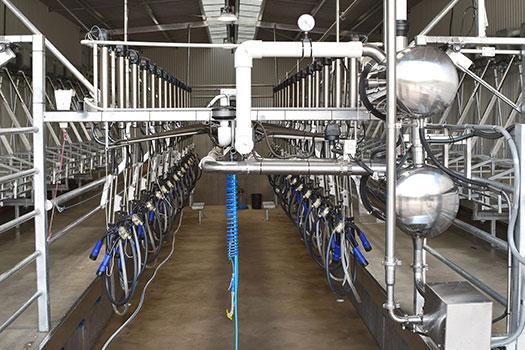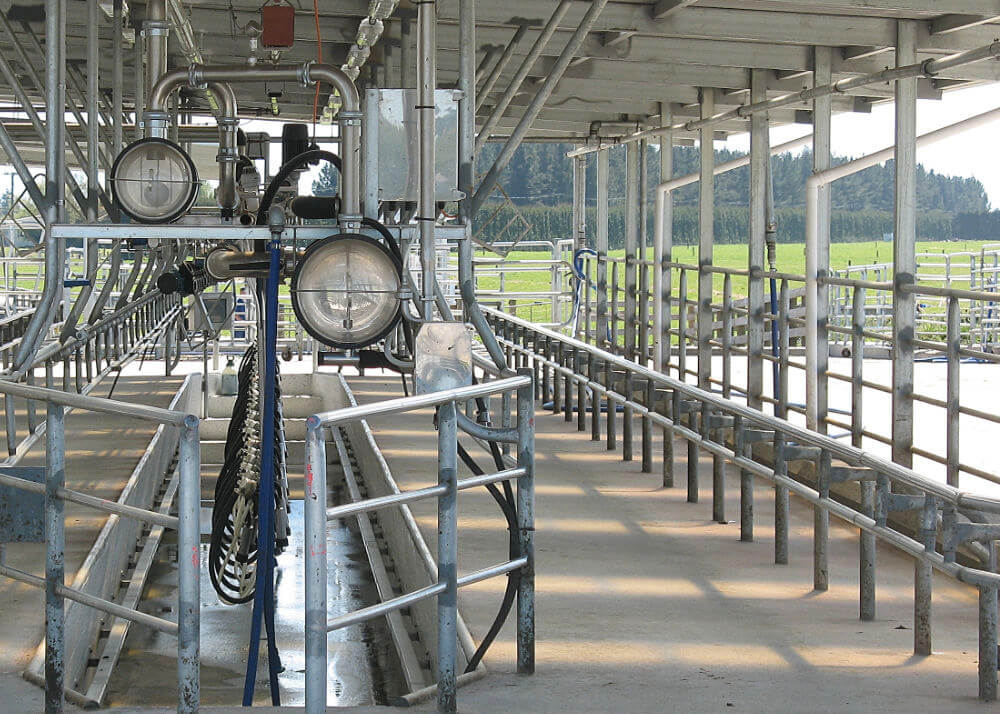The herringbone parlour layout results in a compact working area and allows feeders to be fixed to the side walls. Herringbone milking shed design Written By weyer Friday April 1 2022 Add Comment Edit.

Blueprints And Building Dairynz
Purchased herringbone parallel or simple custom-built stalls are used for the cow platform.

. Assess your herringbones bail entry and exit design with the Milking Smarter book. This design offers the milker a different access point to the udder than the parallel or tandem designs and also allows access for different types of equipment to be used. Resulting in less clean up.
Functional design with an easy access to the udder - GEAs DairyParlor herringbone milking parlor is engineered for an optimal comfortable milking routine. Skylights and windows can help make the most of available natural light while artificial lights like hi-bays are a useful option when there is little or no natural light. See what our customers have to say about our industry-leading 5-year warranty.
No Size Restrictions Our strong clear span designs range from 6 metres to 60 metres and beyond. In the old walk-through sheds each cow was milked at its own speed. In herringbone milking sheds or parlours cows enter in single file and line up almost perpendicular to the central aisle of the milking parlour on both sides of a central pit in which the milker works you can visualise a fishbone with the ribs.
The herringbone and rotary dairy differ in design but how do they differ in their ability to milk cows. New Zealand Goat Farmers Wiebe and Piety Smitstra retrofitted their goat milking shed with a GEA low line double-up herringbone system including automatic cup removers milk meters. The next iteration in milking shed design was the rotary shed.
Our range of steel shed designs is fully adaptable to your needs. 30 60 or 70 milking stalls. The main variations in a Herringbone Dairy are Swing Over Double Up and Walk Through with.
Swing - Swing parlour designs are used to minimize parlour investment. In the old walk-through sheds each cow was milked at its own speed. We understand the importance of ventilation and temperature control.
In Sharps system the cows line up on either side of a central pit where the operator can put on and take off the milking cups without having to bend down. The number of cows milked per hour. Dairy Parlour Design and Construction.
The cows are angled anywhere from 45 to 90 degrees to the pit and the pit which is usually two to three metres wide is where the milking staff work. The farmer stands in a sunken pit in the middle - just like the type of pit a mechanic works from. For small and medium size operations the system when well-designed can provide excellent animal throughput operator and animal comfort and can integrate with many levels of automation.
The number of cows milked per hour. Many vat builders make the mistake of building a slide. By 1972 half of all farms in New Zealand used the new herringbone design and by the early 1980s it was in over 80 per cent of milking sheds where it stayed until another New Zealand shed design became popular.
Herringbone systems are very common in New Zealand and Wide Span Sheds offer a range of steel building solutions that can provide the protective shell for such milking layouts internal design and fit out to be completed by your preferred local specialist. Cow flow is increased - from the race to the herringbone. Pipes and hoses come down from the ceiling.
More detailed information on vat design and construction can be found in Grandin 1980ac 1983a. Large herringbone sheds can milk up to 600 cows efficiently with two people. Recent data manually entered by farmers on the Milksmart website milksmartconz and electronic data obtained in the 201011 season from 80 high tech rotary dairies56.
The data presented in Figure 4 pg 10 are from two sources. The dairy should be well lit but not too bright. Design Try to bring the cows in and turn them round before they enter the yard so they are facing straight down the yard looking out the shed and down the farm.
One of the most common milk sheds the herringbone shed has a central sunken pit and a raised platform on each side where the cows stand whilst being milked. Easy access to the cows for attachment of cups for artificial breeding technicians. Hot-dip galvanised steel structure.
Configure your parlour Download datasheet. Concrete The concrete should not be too smooth. In 1952 Ron Sharp a Waikato dairy farmer developed the herringbone shed design which transformed the milking process.
Herringbones are kind of shaped like a fish skeleton and cows line up on either side where the bones would branch out from the spine. Using our innovative cable lift design Turner Herringbone Stalls lift perfectly every time and are not restricted by low ceilings. The milking unit is used on two stalls and is swung from one side of the parlour pit to the other.
The Herringbone dairy design is named after the herringbone pattern that is created by the layout. In Sharps system the cows line up on either side of a central pit where the operator can put on and take off the milking cups without having to bend down. Herringbone Herringbone parlors are the most common design used on dairy farms with smaller herds.
Benefits of a Herringbone Milking Shed System. Milklines herringbone milking parlours are available in different configurations - 30 60 or 70 side milking - and with different options to best suit your needs. The Herringbone Dairy is still the most widely used dairy style in Australia.
The herringbone shed was developed by Ron Sharp a farmer from the Waikato in 1952. Apparently there is a concrete made from river stone which is very smooth and the cows slip over on it. The animal will seldom attempt to back out because it does not start slipping.
In 1952 Ron Sharp a Waikato dairy farmer developed the herringbone shed design which transformed the milking process. They come into the parlour and line up between each fishbone creating two rows of cows. Walking distance between cows is 69-76 cm 27-30 in.
Four stands on each side of the pit as shown in Figure 1016c is the minimum size of this type for high labour efficiency. Our designs optimize stock performance. The design of your dairy shed should centre around the comfort and safety of both cows and workers.
This also gives better cow flow. We can personalise your dairy farm shed to suit exactly what you require. A slide is a bad design because the cattle sometimes flip over backwards while going down the slide.
The cattle stand at a 45-degree angle. Stainless steel pit edge protection.

The Changing Face Of The Nz Cow Shed Number 8 Network
Farm Structures Ch10 Animal Housing Cattle Housing Milking Parlour

Herringbone Bail And Pit Design Dairynz

Herringbone Dairy Swing Over Double Up Larsen Stalls Exit Gates Entry Gates Daviesway

Using A Herringbone Dairy Shed Farm Buildings Te Ara Encyclopedia Of New Zealand


0 comments
Post a Comment